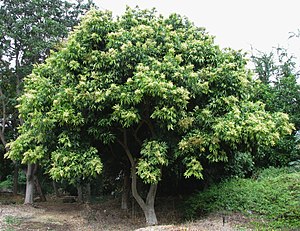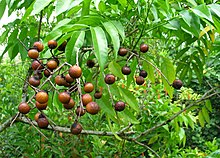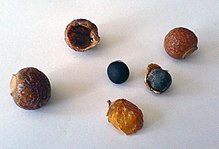Soapnut tree
| Soapnut tree | ||||||||||||
|---|---|---|---|---|---|---|---|---|---|---|---|---|

Soapnut tree ( Sapindus saponaria var. Saponaria ) |
||||||||||||
| Systematics | ||||||||||||
|
||||||||||||
| Scientific name | ||||||||||||
| Sapindus saponaria | ||||||||||||
| L. |
The soap nut tree ( Sapindus saponaria ), like many other plant species also called soap tree , is a plant species within the soap tree family (Sapindaceae). It occurs in tropical and subtropical regions of South and Central America as well as in the Caribbean . The most valuable part of the plant is its fruit, which has been used for washing for thousands of years.
The Indian soap nut Sapindus mukorossi and Sapindus trifoliatus from India and Southeast Asia are similar .
description
The soapnut tree grows as a mostly evergreen tree that can reach heights of up to 20 meters and can live for seventy years or more. The straight, cylindrical trunk reaches a circumference of 1.5 to 5.5 meters, but buttress roots can also be formed. The bark of young trees is brownish to light gray and smooth, in older trees it is grayish and cracked to scaly or flaky.
The alternate leaves are divided into a petiole and a leaf blade. The leaf blade is usually pinnate in pairs with 8 to 16 short-stalked, thin, entire-margined and pointed to acuminate, egg-shaped to lanceolate or lanceolate, papery leaflets . The leaflets are partly crescent-shaped and about 7-17 centimeters long, the blade is partly somewhat uneven. The almost bald petiole is up to 4–8 inches long. The rachis and the petiole are sometimes short-winged, especially with young leaves.
The soapnut tree is duodichogamous . Long, fine-haired and paniculate inflorescences are formed. The green-whitish, short-stalked, slightly fragrant, mostly unisexual, five-fold and very small flowers have a double flower envelope . Two of the petaloid sepals are smaller than the other three. The petals are mostly ciliate. The approximately 8 stamens have hairy stamens in the lower part. The stalked, almost bald ovary is on top and the stigma is three-lobed. There is a bare discus . The male flowers have a pistillode and the female have staminodes.
The flowers are predominantly male, with some female flowers and also some hermaphrodite.
At the age of ten, the tree bears the first fruits, initially orange, sticky, round and slightly wrinkled stone fruits with a translucent, gelatinous and leathery pericarp. The rounded fruits usually appear individually or up to three in a split fruit . The individual partial fruits are about 1.2-1.8 centimeters in size and are harvested in September. After drying, the peel of the fruit is "nut" hard and no longer sticky and red to dark brown. They usually contain only a large, black and smooth, very hard, about 9-14 millimeters large, finely pitted stone core, flattened on one side, which lies fairly freely in the fruit shell. The fruit shell and the seeds contain up to 15-30% saponins , the quality of which is determined by the harvest time and the age of the tree. The fruits often stay on the tree for a very long time. The stone cores (seeds) are considered poisonous.
The number of chromosomes is 2n = 28.
Occurrence
The soapnut tree is originally widespread from central to northern South America to Central America and the Caribbean . It prefers a sunny location and well-drained soil. It grows well in different soils, including stony or dry and nutrient-poor. Older plants are also drought resistant and can also endure salty winds.
Systematics
It was first published in 1753 by Carl von Linné in Species Plantarum , 1, p. 367. It is the lectotype of the genus. The generic name Sapindus is derived from the Latin sapo = soap and indicus for India, the epithet saponaria comes from the Latin sapo here for saponin.
Synonyms of Sapindus saponaria L. are: Cupania saponarioides Sw. , Sapindus abruptus Lour. Cambess , Sapindus divaricatus . , Sapindus forsythii DC. , Sapindus inaequalis DC. , Sapindus inaequialis DC. , Sapindus indica Poir. , Sapindus peruvianus var. Dombeyanus Walp. , Sapindus peruvianus var. Meyenianus Walp. Walp , Sapindus peruvianus . , Sapindus rigidus Mill. , Sapindus saponaria fo. genuinus Radlk. , Sapindus stenopterus DC. Rock , Sapindus thurstonii , Sapindus turczaninowii Vidal .
There are three varieties of the species:
- Sapindus saponaria var. Drummondii (Hook. & Arn.) LDBenson (Syn .: Sapindus drummondii Hook. & Arn. ) (From some authors as a separate species): Colorado , New Mexico
- Sapindus saponaria var. Inaequalis Radlk. : Guyana , Suriname and French Guiana
- Sapindus saponaria L. var. Saponaria
use
For washing, only the dried, "nut" hard fruit casings in a cotton bag are put into the drum for washing. Depending on the washing temperature and water hardness, the required amount varies from three to seven "nut" halves for a washing machine load. The soap nuts can be used for two washes at washes up to 40 ° C. Unlike conventional detergents, soapnuts have no water- softening or textile bleaching effect and do not release any odorous substances into the laundry. If necessary, bleach , water softeners and fragrances such as essential oils are added to the laundry . As an alternative to the water softener, the washing solution can be acidified with citric acid, as saponin is also effective in acidic solution.
The washing effect of soapnuts when cleaning textiles is controversial. In a test, Stiftung Warentest determined poor stain removal and a tendency for white laundry to turn gray.
Since the active ingredients are also released into the water during the rinse cycles when used in the laundry drum, active ingredients also get into the laundry during the final phase of cleaning and therefore cannot be completely washed out. With modern machines, however, you can wash with the hold button, let the water pump out, remove the bag of nuts and only then start the wash cycle. One wash cycle requires soap nuts worth around EUR 0.10.
The brew of soapnuts boiled in water can be used as shower powder , shampoo or all-purpose cleaner for the household. The water extract from the soapnut shell is said to have an effect against various phytopathogenic fungi. The kernel of the soap nut and any remains of the shell after use can be composted. The washing-active substances in the soap nut are considered to be easily biodegradable.
Alternatively, the can chestnut the horse chestnut be used for washing, which also contain saponins.
criticism
Due to the increasing use of soap nuts in Western Europe, their price in India, their country of origin, increased sixfold between 2003 and 2008, so that the price of soap nuts as a detergent decreased compared to other detergents.
The saponins contained in a large number of plants are toxic to fish in higher concentrations . A comparison with conventional detergents carried out by Stiftung Warentest gave a disappointing result on the washing effect of soap nuts.
Individual evidence
- ↑ a b Sapindus saponaria in the Germplasm Resources Information Network (GRIN), USDA , ARS , National Genetic Resources Program. National Germplasm Resources Laboratory, Beltsville, Maryland. Retrieved August 31, 2013.
- ↑ R. Langdon: The soap berry, a neglected clue to Polynesia's prehistoric past. In: The Journal of the Polynesian Society. 105 (2), 1996, pp. 185-200, online .
- ↑ Sapindus saponaria at Tropicos.org. In: IPCN Chromosome Reports . Missouri Botanical Garden, St. Louis
- ↑ First publication scanned at biodiversitylibrary.org .
- ↑ Sapindus saponaria at Tropicos.org. Missouri Botanical Garden, St. Louis, accessed August 31, 2013.
- ↑ Sapindus saponaria at Kew Science.
- ↑ Soapnuts & Co. - Cleaning effect of alternative washing methods (PDF) Study by the University of Bonn, 2013, accessed on January 12, 2018.
- ↑ a b Soap nuts and chestnuts: The gray way to wash. In: Stiftung Warentest test. August 2019, pp. 58–59, online .
- ↑ Dirty laundry thanks to the organic boom . In: Taz Online. March 11, 2008.
- ↑ Oliver Nagel: A clear conscience - environmentally conscious Europeans make Indian soapnuts priceless. In: Thomas Osterkorn, Andreas Petzold (Ed.): Neon . Hamburg June 2008, p. 31.
- ↑ Eberhard Breitmaier & Günther Jung: Organic chemistry. Thieme Verlag, 1978, 2005, ISBN 3-13-541505-8 , section 42.5.5.
literature
- K. Kubitzki : The Families and Genera of Vascular Plants. Vol. X: Flowering Plants Eudicots , Springer, 2011, ISBN 978-3-642-14396-0 , p. 399.
- Nora Kircher: Soapnuts & Co. - detergents that you can pick. Frank Jaspers Verlag, Bawinkel 2008, ISBN 978-3-938090-22-0 .
- James Macfadyen: The Flora of Jamaica. Vol. I, 1837, p. 159 f, limited preview in Google book search.
- Forrest Shreve, Ira L. Wiggins: Vegetation and Flora of the Sonoran Desert. Volume 1, Stanford Univ. Press, 1964, ISBN 0-8047-0163-6 , p. 855.
Web links
- Sapindus saponaria at Useful Tropical Plants.
- Trees in Landscape, Part 6: Sapindus saponaria (PDF), at Univ. of California, Agriculture and Natural Resources, accessed September 26, 2019.
- Sapindus saponaria from Southern Rocky Mountain Herbaria, accessed on September 26, 2019 (with many pictures).



